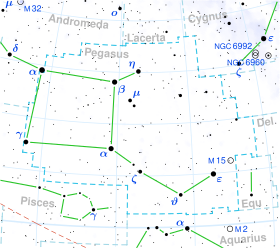| Observation data Epoch J2000 Equinox J2000 | |
|---|---|
| Constellation | Pegasus |
| Right ascension | 23h 33m 57.18791s[1] |
| Declination | 31° 19′ 31.0058″[1] |
| Apparent magnitude (V) | 4.97[2] |
| Characteristics | |
| Spectral type | K4IIIb[3] |
| U−B color index | +1.63[4] |
| B−V color index | +1.39[4] |
| Variable type | suspected[5] |
| Astrometry | |
| Radial velocity (Rv) | −24.71[6] km/s |
| Proper motion (μ) | RA: +50.81[1] mas/yr Dec.: −17.46[1] mas/yr |
| Parallax (π) | 5.94 ± 0.45 mas[1] |
| Distance | 550 ± 40 ly (170 ± 10 pc) |
| Absolute magnitude (MV) | −1.15[2] |
| Orbit[7] | |
| Period (P) | 492.30 ± 75.96 a (179,811 ± 27,745 d) |
| Semi-major axis (a) | 0.568 ± 0.065″ |
| Eccentricity (e) | 0.322 ± 0.047 |
| Inclination (i) | 21.7 ± 8.3° |
| Longitude of the node (Ω) | 56.2 ± 6.0° |
| Periastron epoch (T) | MJD 16818 ± 3658 |
| Argument of periastron (ω) (secondary) | 293 ± 15° |
| Details | |
| Mass | 2 / 2[7] M☉ |
| Luminosity | 554[2] L☉ |
| Surface gravity (log g) | 2.00[8] cgs |
| Temperature | 4,379[9] K |
| Metallicity [Fe/H] | +0.06[2] dex |
| Rotational velocity (v sin i) | 1.4[10] km/s |
| Other designations | |
| Database references | |
| SIMBAD | data |
72 Pegasi is a binary star system in the northern constellation of Pegasus. It is visible to the naked eye as a faint, orange-hued point of light with a combined apparent visual magnitude of 4.97.[2] The system is located approximately 550 light years away from the Sun, based on parallax,[1] but is drifting closer with a radial velocity of −25 km/s.[6]
This is a visual binary with an orbital period of roughly 492 years and an eccentricity of 0.32. The two stars are relatively similar and are about twice the mass of the Sun each. The primary star, 72 Pegasi A, is an evolved K-type giant with a visual magnitude of 5.67. The companion, 72 Pegasi B, is another K-type giant with an apparent magnitude of 6.11, and a separation of about 0.568″ from the primary. 72 Pegasi B is thought to be a binary itself, with a brown dwarf companion in a 4.2-year period.[7]
- ^ a b c d e f Van Leeuwen, F. (2007). "Validation of the new Hipparcos reduction". Astronomy and Astrophysics. 474 (2): 653–664. arXiv:0708.1752. Bibcode:2007A&A...474..653V. doi:10.1051/0004-6361:20078357. S2CID 18759600. Vizier catalog entry
- ^ a b c d e Anderson, E.; Francis, Ch. (2012). "XHIP: An extended hipparcos compilation". Astronomy Letters. 38 (5): 331. arXiv:1108.4971. Bibcode:2012AstL...38..331A. doi:10.1134/S1063773712050015. S2CID 119257644. Vizier catalog entry
- ^ Hoffleit, D.; Warren, W. H. (1995). "VizieR Online Data Catalog: Bright Star Catalogue, 5th Revised Ed. (Hoffleit+, 1991)". VizieR On-line Data Catalog: V/50. Originally Published in: 1964BS....C......0H. 5050. Bibcode:1995yCat.5050....0H.
- ^ a b Mermilliod, J. C. (2006). "VizieR Online Data Catalog: Homogeneous Means in the UBV System (Mermilliod 1991)". VizieR On-line Data Catalog: II/168. Originally Published in: Institut d'Astronomie. 2168. Bibcode:2006yCat.2168....0M.Vizier catalog entry
- ^ Samus, N. N.; Durlevich, O. V.; et al. (2009). "VizieR Online Data Catalog: General Catalogue of Variable Stars (Samus+ 2007-2013)". VizieR On-line Data Catalog: B/GCVS. Originally Published in: 2009yCat....102025S. 1: B/gcvs. Bibcode:2009yCat....102025S.
- ^ a b Famaey, B.; et al. (2005). "Local kinematics of K and M giants from CORAVEL/Hipparcos/Tycho-2 data". Astronomy & Astrophysics. 430: 165–186. arXiv:astro-ph/0409579. Bibcode:2005A&A...430..165F. doi:10.1051/0004-6361:20041272. S2CID 17804304.
- ^ a b c Muterspaugh, Matthew W.; et al. (2010). "The Phases Differential Astrometry Data Archive. V. Candidate Substellar Companions to Binary Systems". The Astronomical Journal. 140 (6): 1657. arXiv:1010.4048. Bibcode:2010AJ....140.1657M. doi:10.1088/0004-6256/140/6/1657. S2CID 59585356.
- ^ Soubiran, Caroline; Le Campion, Jean-François; Brouillet, Nathalie; Chemin, Laurent (2016). "The PASTEL catalogue: 2016 version". Astronomy & Astrophysics. 591: A118. arXiv:1605.07384. Bibcode:2016A&A...591A.118S. doi:10.1051/0004-6361/201628497. S2CID 119258214.
- ^ McDonald, I.; Zijlstra, A. A.; Boyer, M. L. (2012). "Fundamental parameters and infrared excesses of Hipparcos stars". Monthly Notices of the Royal Astronomical Society. 427 (1): 343–357. arXiv:1208.2037. Bibcode:2012MNRAS.427..343M. doi:10.1111/j.1365-2966.2012.21873.x. S2CID 118665352. Vizier catalog entry
- ^ De Medeiros, J. R.; Mayor, M. (1999). "A catalog of rotational and radial velocities for evolved stars". Astronomy and Astrophysics Supplement Series. 139 (3): 433. arXiv:astro-ph/0608248. Bibcode:1999A&AS..139..433D. doi:10.1051/aas:1999401. Vizier catalog entry
- ^ "72 Peg". SIMBAD. Centre de données astronomiques de Strasbourg. Retrieved 2019-07-05.
